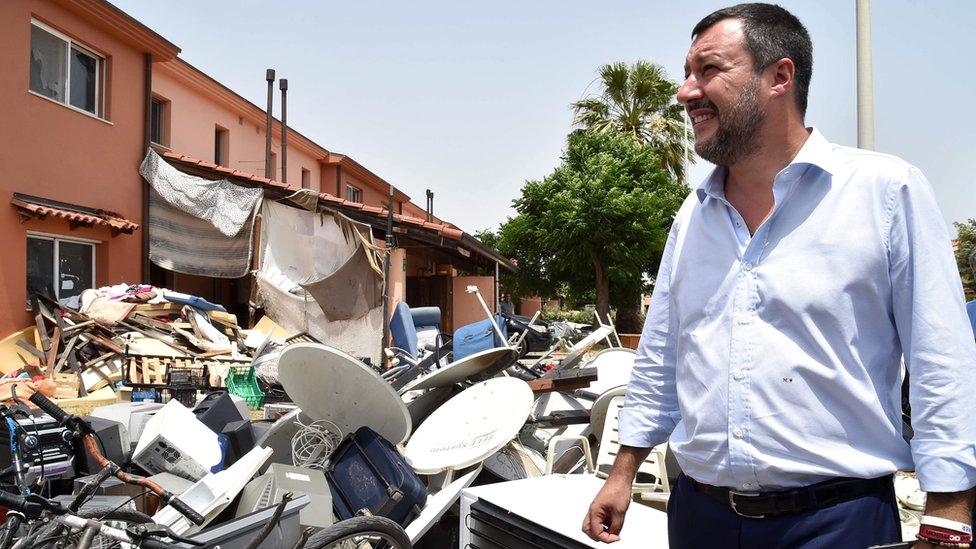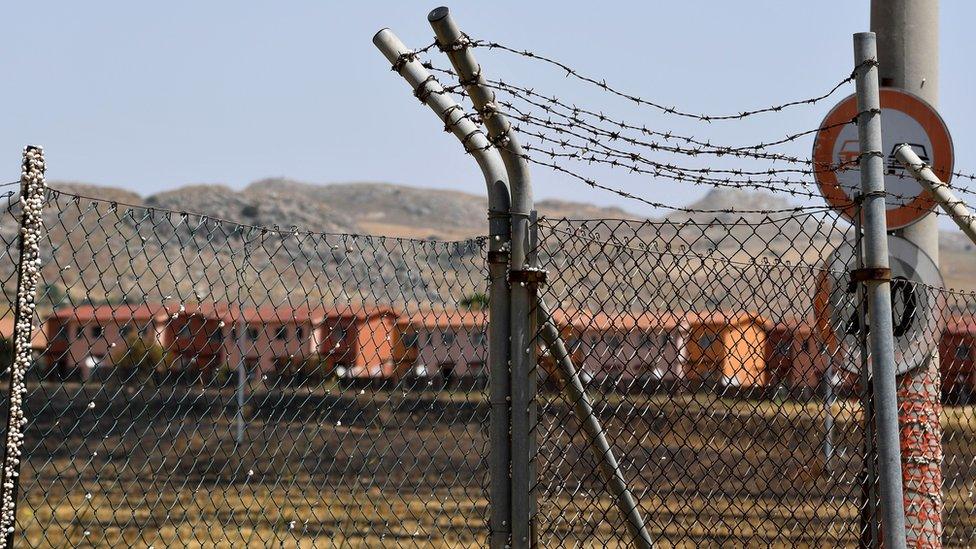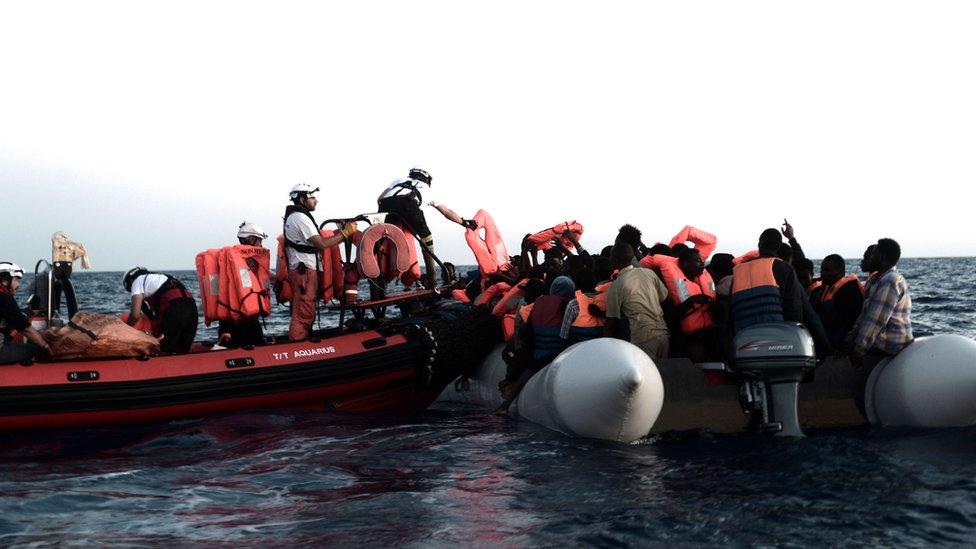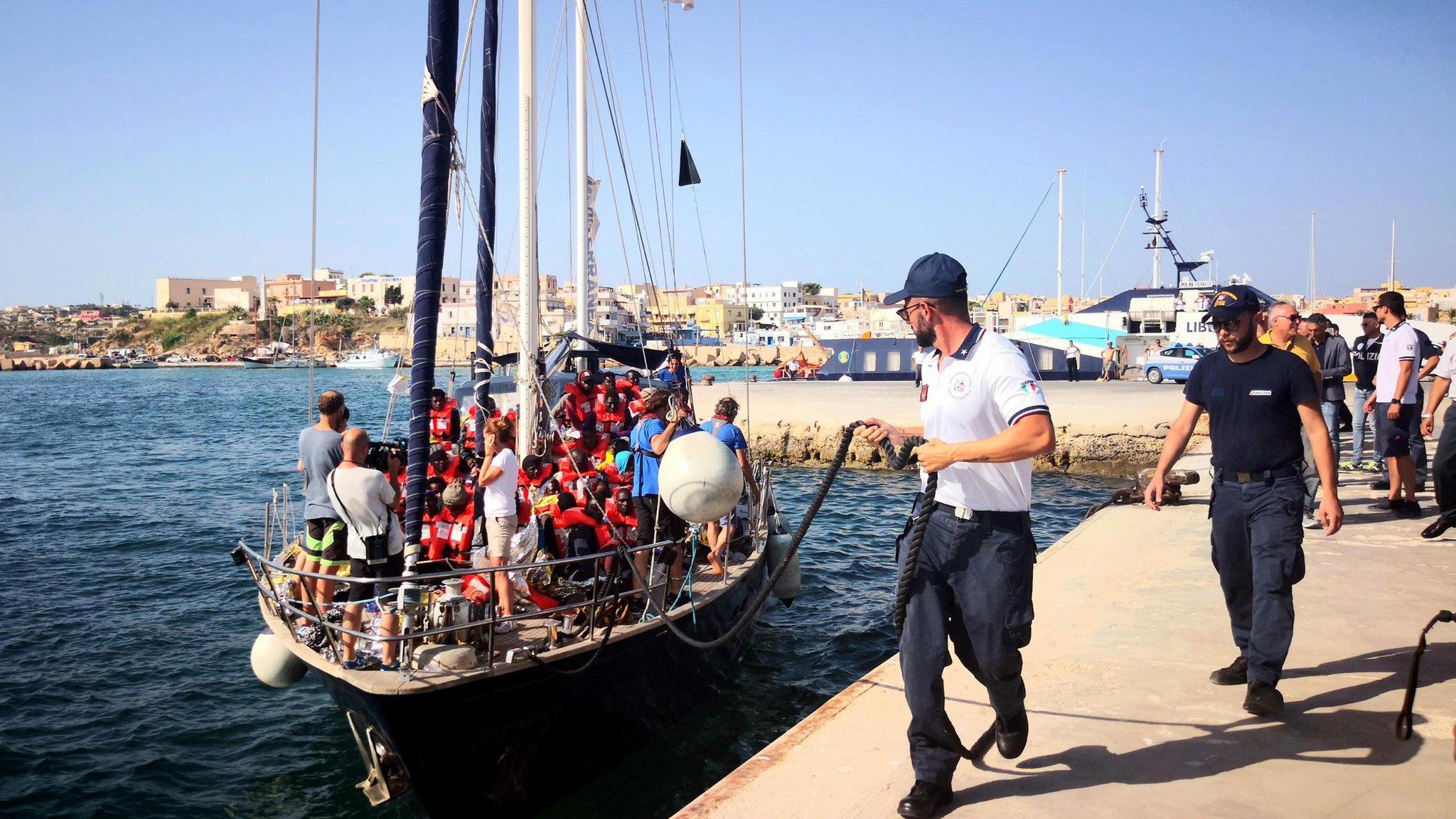Italy's Salvini shuts Europe's one-time largest migrant centre
- Published

Matteo Salvini was followed around the empty camp by the press
A migrant centre on the Italian island of Sicily which had been one of the largest of its kind in Europe has been officially shut down.
Interior Minister Matteo Salvini attended the closure of the Mineo centre, which at its peak housed more than 4,000 people.
The leader of the populist, right-wing League party, has spearheaded Italy's hard-line stance toward migration.
He live-streamed a walkabout tour of the empty facility on Tuesday.
Italy is the main entry for migrants crossing the Mediterranean from North Africa to Europe. Its populist government has tried to reduce the number of people arriving by banning rescue ships bearing migrants from docking at its ports.
While the number of arrivals on Italian territory has fallen dramatically from the total of 181,000 in 2016 to 3,071 so far this year, the proportion of dead and missing has climbed to 667 - more than one in six.

Remaining migrants at the camp were transferred ahead of Tuesday's closure
Hours ahead of Tuesday's closure, an Italian customs boat arrived at the Sicilian port of Pozzallo carrying 47 rescued migrants who had been travelling to Italy's Lampedusa island.
The migrants were said to come from Tunisia and sub-Saharan Africa.
Migration and Home Affairs Commissioner Dimitris Avramopoulos has called on the bloc's 28 member states to reach a temporary arrangement on taking in migrants until permanent reforms are agreed.
"The challenges of migration cannot only be the responsibility of Italy and Malta simply because these states are located on the Mediterranean," he told Germany's Die Welt.
The EU's own four-year Mediterranean sea patrol mission, credited with rescuing thousands of migrants, is being suspended at the end of September, amid a row with Italy over where the saved migrants should disembark.
What has Salvini said about Mineo?
In 2017, Mr Salvini filmed himself spending a night at the Mineo migrant centre, a former US military base in Sicily.
He later described what he witnessed as "organised migration" aimed at "replacing the Italian people with other people, Italian workers with other workers".

Before it became a centre for migrants, Mineo was a US military base
The decision to close the Mineo centre was announced last month, after the number of asylum seekers there declined from 2,526 a year ago to 152, Ansa news agency reported.
The remaining migrants were transferred to smaller centres ahead of Tuesday's closure.
At the time of the announcement, Mr Salvini said Italy's policy of closing ports had brought about the closure of other big migrant centres and "now it's Mineo's turn".
He said it was "good news" for local residents, citing the murder of an elderly couple in 2015 at the hands of an Ivorian teenager who had been living in the Mineo camp.
What's the latest on migrants reaching Europe?
In addition to the 47 migrants taken to Sicily on Tuesday, a German charity ship, the Alan Kurdi, said it had rescued 44 migrants from a wooden boat in the Mediterranean, adding that it would deliver them to Malta.
Its operator, Sea-Eye, said the country had agreed to accept those on board, including women and children, and was sending a vessel to pick them up.
Allow X content?
This article contains content provided by X. We ask for your permission before anything is loaded, as they may be using cookies and other technologies. You may want to read X’s cookie policy, external and privacy policy, external before accepting. To view this content choose ‘accept and continue’.

Last week, the Alan Kurdi rescued 65 migrants off the coast of Libya and handed them to the Maltese navy after Italy closed its ports to the vessel.
Prime Minister Joseph Muscat said after talks with the European Commission and German government that all 65 would be relocated to other parts of the EU.
Migrants are brought to Valetta, Malta
On Tuesday, Mr Salvini said maritime surveillance in the Mediterranean needed to be "accelerated" and suggested the use of passenger ships to repatriate migrants to Tunisia.
Italy's defence ministry is also reportedly planning to send navy vessels to accompany its coastguard to Italian ports to block humanitarian ships carrying migrants, according to Italian newspaper La Repubblica.
What is behind Italy's policy?
Mr Salvini, whose populist government came to power a year ago, accuses humanitarian groups operating in the Mediterranean of encouraging North African smuggling routes.
Italy is often the closest EU nation when migrants are rescued off the coast of Libya - which many organisations do not consider safe.
Last month, Italy's cabinet passed laws allowing for fines of up to €50,000 (£45,000; $56,000) to be issued to boats that sail to Italian ports without permission.
Tensions over the country's policy escalated last month when the charity ship Sea-Watch 3 forced a landing on the Italian island of Lampedusa. It had been stranded at sea for two weeks while awaiting permission to dock.
Mr Salvini accused the ship's captain, Carola Rackete, of committing "an act of war" after her boat trapped an Italian patrol boat against a quayside.
Ms Rackete, who was aware that entering Italian waters risked serious consequences, said her decision was "not an act of violence" but simply an attempt to get "exhausted and desperate" people on to dry land.
She was arrested but has been cleared by an Italian court of endangering lives. She still faces charges for people smuggling and resisting the authorities and is due to appear in court again on 18 July.
- Published12 June 2019

- Published7 July 2019

- Published24 September 2019

- Published13 June 2018